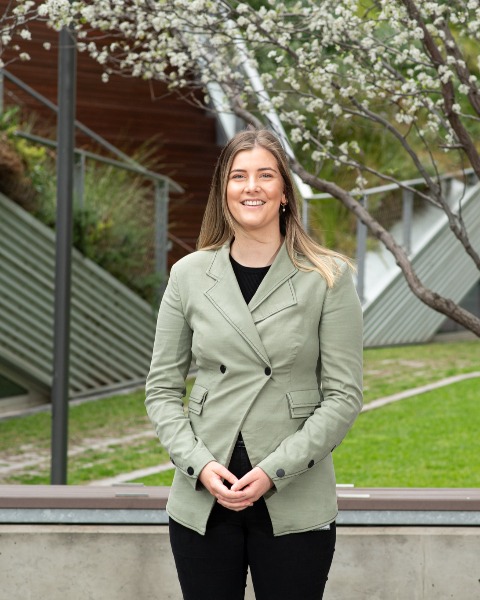Oral Presentation
Session: Tracking Trends Around The World
National trends in antidepressant utilisation within Australian residential aged care facilities, 2006-2019
Sunday, August 27, 2023
9:00 AM - 10:00 AM ADT
Location: MR202
Publication Number: 234

Georgina A. Hughes, B.Pharm (Hons) B.PharmSc (she/her/hers)
PhD Candidate
UniSA Clinical & Health Sciences, University of South Australia, Adelaide, South Australia, Australia
Presenting Author(s)
Background: Antidepressants are increasingly used among older people, including in Australia, which has the third highest consumption of antidepressants compared to other Organisation for Economic Cooperation and Development countries. Australia’s recent Royal Commission into Aged Care Quality and Safety identified potentially inappropriate prescribing of psychotropic medicines in residential aged care facilities (RACFs), prompting increased attention to safe use of benzodiazepines and national monitoring of antipsychotics. However, antidepressant use, despite being the most frequently prescribed psychotropic medicine to residents of RACFs, remains largely unexplored.
Objectives: To examine national trends in antidepressant use among older people living in Australian RACFs between 2006 and 2019.
Methods: This repeated, cross-sectional analysis used data from the National Historical Cohort of the Registry of Senior Australians, which contains linked pharmaceutical, health, and aged care information for >3.5 million residents accessing aged care services between 2002 and 2020. Permanent, long-term (≥100 days) residents of Australian RACFs aged ≥65 years were included. Age and sex adjusted annual prevalence of antidepressant use (overall, and by antidepressant type and class) from 2006 – 2019 was determined using pharmaceutical claims data dispensing records. Poisson regression models adjusting for age and sex estimated incidence rate ratios (IRRs) and 95% confidence intervals (CIs). Analyses were conducted for the overall cohort from 2006 – 2019, and by subgroups with a dementia diagnosis from 2009 onwards due to aged care assessment data availability.
Results: 779,659 residents from 3,371 RACFs were studied (786,227,380 resident-days), with a median age of 85 years (IQR 80-89). Two-thirds (65.2%) were female, 48.6% had dementia and 33.6% had depression. Overall, antidepressant use increased from 46.1% (95%CI 45.9 – 46.4) in 2006 to 58.5% (95%CI 58.3 – 58.8) in 2019 (IRR 1.02, 95%CI 1.02 – 1.02). Mirtazapine use increased from 8.4% (95%CI 8.2 – 8.5) in 2006 to 20.9% (95%CI 20.7 – 21.1) in 2019 (IRR 1.07, 95%CI 1.07 – 1.07), in contrast to trends in use of other antidepressants which remained steady. In residents with dementia, crude prevalence of antidepressant use increased from 39.5% (95%CI 39.2 – 39.8) in 2009 to 47.6% (95%CI 47.3 – 47.9) in 2019, compared with 44.6% (95%CI 44.3 – 44.9) in residents without dementia in 2009 to 48.3% (95%CI 48.0 – 48.6) in 2019.
Conclusions: This nationwide study shows increasing trends in antidepressant use among Australian RACFs between 2006 and 2019, largely driven by increased use of mirtazapine. Continued monitoring for the safe and effective use of antidepressants is needed to optimise use among residents of RACFs.
Objectives: To examine national trends in antidepressant use among older people living in Australian RACFs between 2006 and 2019.
Methods: This repeated, cross-sectional analysis used data from the National Historical Cohort of the Registry of Senior Australians, which contains linked pharmaceutical, health, and aged care information for >3.5 million residents accessing aged care services between 2002 and 2020. Permanent, long-term (≥100 days) residents of Australian RACFs aged ≥65 years were included. Age and sex adjusted annual prevalence of antidepressant use (overall, and by antidepressant type and class) from 2006 – 2019 was determined using pharmaceutical claims data dispensing records. Poisson regression models adjusting for age and sex estimated incidence rate ratios (IRRs) and 95% confidence intervals (CIs). Analyses were conducted for the overall cohort from 2006 – 2019, and by subgroups with a dementia diagnosis from 2009 onwards due to aged care assessment data availability.
Results: 779,659 residents from 3,371 RACFs were studied (786,227,380 resident-days), with a median age of 85 years (IQR 80-89). Two-thirds (65.2%) were female, 48.6% had dementia and 33.6% had depression. Overall, antidepressant use increased from 46.1% (95%CI 45.9 – 46.4) in 2006 to 58.5% (95%CI 58.3 – 58.8) in 2019 (IRR 1.02, 95%CI 1.02 – 1.02). Mirtazapine use increased from 8.4% (95%CI 8.2 – 8.5) in 2006 to 20.9% (95%CI 20.7 – 21.1) in 2019 (IRR 1.07, 95%CI 1.07 – 1.07), in contrast to trends in use of other antidepressants which remained steady. In residents with dementia, crude prevalence of antidepressant use increased from 39.5% (95%CI 39.2 – 39.8) in 2009 to 47.6% (95%CI 47.3 – 47.9) in 2019, compared with 44.6% (95%CI 44.3 – 44.9) in residents without dementia in 2009 to 48.3% (95%CI 48.0 – 48.6) in 2019.
Conclusions: This nationwide study shows increasing trends in antidepressant use among Australian RACFs between 2006 and 2019, largely driven by increased use of mirtazapine. Continued monitoring for the safe and effective use of antidepressants is needed to optimise use among residents of RACFs.

